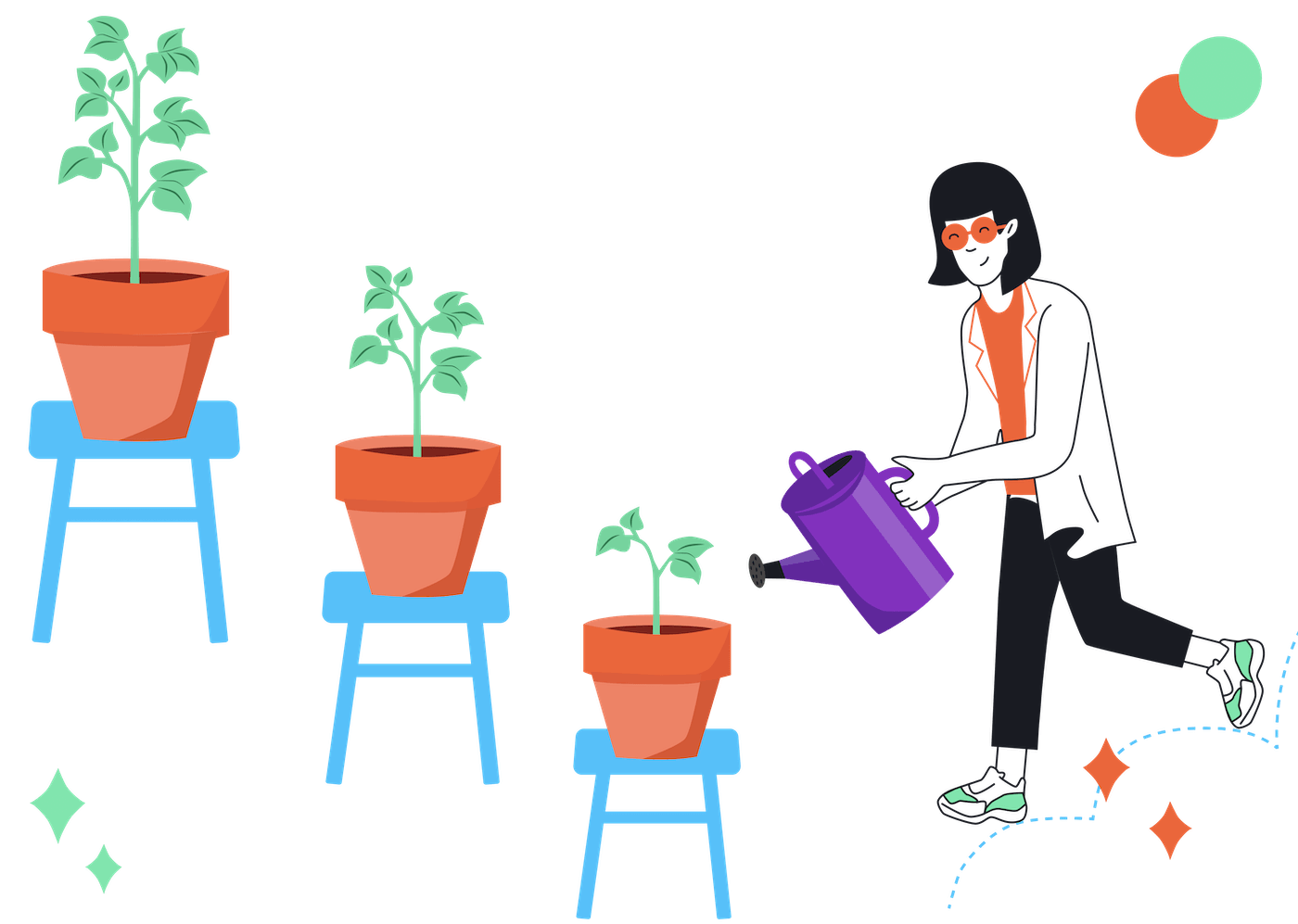There’s no doubt that email marketing is a powerful tool for lead conversion. And ideally, leads would convert whenever they receive a marketing email. But, in reality, they ignore emails, hit the unsubscribe button, and sometimes even report them as spam.
Enter the email nurture campaign!
If you want leads to open your emails, click through and convert, you must first build a strong relationship with them.
Email nurture campaigns enable you to send targeted emails that engage with leads on a personal level and guide them through the buyer’s journey until they convert.
In this article, you will learn how to use email nurture campaigns to convert leads into loyal customers, including tips on how to write attractive nurture emails, and email lead nurturing best practices.
Sounds good? Let’s get into it.
What is an Email Nurture Campaign?
In the context of email marketing, to “nurture” means to cultivate a relationship. Hence, an email nurture campaign involves sending a series of engaging emails to build a strong relationship with contacts and leads, which results in them becoming customers.
Nurture emails enable you to pique your leads’ interest and curiosity, educate and engage them, solve their problems and pain points, gain their trust, and compel them to take action. This moves them through the different stages of the buyer’s journey until they convert to customers.
For instance, we received this invitation to a webinar from GetResponse.
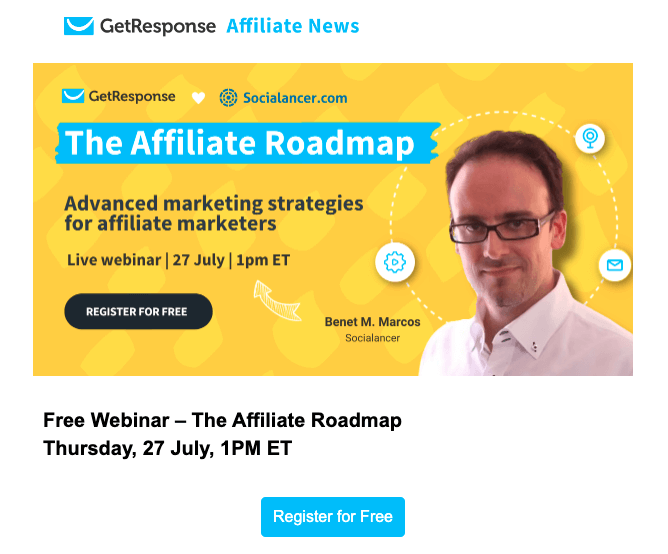
After the event they could create an email nurture campaign, containing recordings of the webinar, key takeaways, free consultation offers, and client success stories. These emails would be sent over a couple of days to build a relationship with the leads and possibly convert them into paying customers.
Email Nurture Campaigns vs Drip Campaigns
Email nurture campaigns and drip campaigns are similar and often used interchangeably. However, although they are both types of automated email marketing, they are different.
Email nurture campaigns are action-based campaigns. They are automated email sequences sent based on your lead’s behaviors. This means that your lead’s actions (or inactions) determine the content of the email and when you send it.
On the other hand, drip campaigns are time-based campaigns. They are automated email sequences delivered on a set schedule. This means that they are sent at a specified time, irrespective of your lead’s actions (or inactions).
Furthermore, email nurture campaigns are more targeted and personalized to each lead. So, to create a nurture email, you need insights about their actions and behaviors. Hence, leads may receive different nurture emails depending on their actions.
For instance, imagine two leads visit an ecommerce store. They both add a product to their cart, but ‘Lead A’ doesn’t complete the order; only ‘Lead B’ checks out.
Lead A, who didn’t check out, would trigger an abandoned cart nurture email campaign that would push them to complete the order. While Lead B would trigger a cross-sell nurture email campaign promoting related or complimentary products.
To set up a drip campaign, you only need to predetermine a specific time or schedule to send the emails automatically. And the same email content is sent to all contacts and leads.
One example is a recent drip marketing campaign I created for a cryptocurrency platform. The campaign was an email course offered to re-engage contacts on their email list, and was sent as scheduled below.
Day 1: Send an email offering a free email course
Day 2: Send an email about why exchanges are not safe
Day 4: Send an email about the importance of crypto security
Day 6: Send an email about cold and hardware crypto wallets
…and so on.
As you can see, the emails didn’t depend on the contacts’ behaviors. Everyone who opted-in for the email course got the same email on the specified day.
Why Create an Email Nurture Campaign?
Creating an email nurture campaign helps you build a strong relationship with your contacts and leads, which can ultimately:
- Increase email engagement. With nurture email campaigns, your email open and click-through rate will increase. Because of the relationship you’re building, your leads are more likely to look forward to receiving your emails, and to engage with them more.
- Convert more leads. Nurture email campaigns enable you to warm up leads, address their objections, and build trust in your business. And, as they engage with your emails, they are more likely to convert to customers.
- Retain more customers. When you continue to send nurture emails after leads convert, they’ll become returning customers and even brand ambassadors who will recommend your business to their family and friends.
Email Lead Nurturing Best Practices
Here are some email lead nurturing best practices to help you optimize your campaign to nurture and convert more leads.
1. Personalize the nurture emails
Getting personal is crucial when building any type of relationship, including those with email contacts and leads. So, you need to personalize your nurture emails to really connect with your leads.
Email personalization involves customizing your emails with relevant personal information about your leads. And, this is much more than using their names or calling out their location in the email subject line (although this is a good idea too).
You can also use personal information indirectly. For example, if you know the gender of your contact, you can use it to include gender-specific graphics or images in your nurture email.
An example is this Adidas email. The emails sent to men had a pic of Pharell, while those sent to women had a pic of Rita Ora.
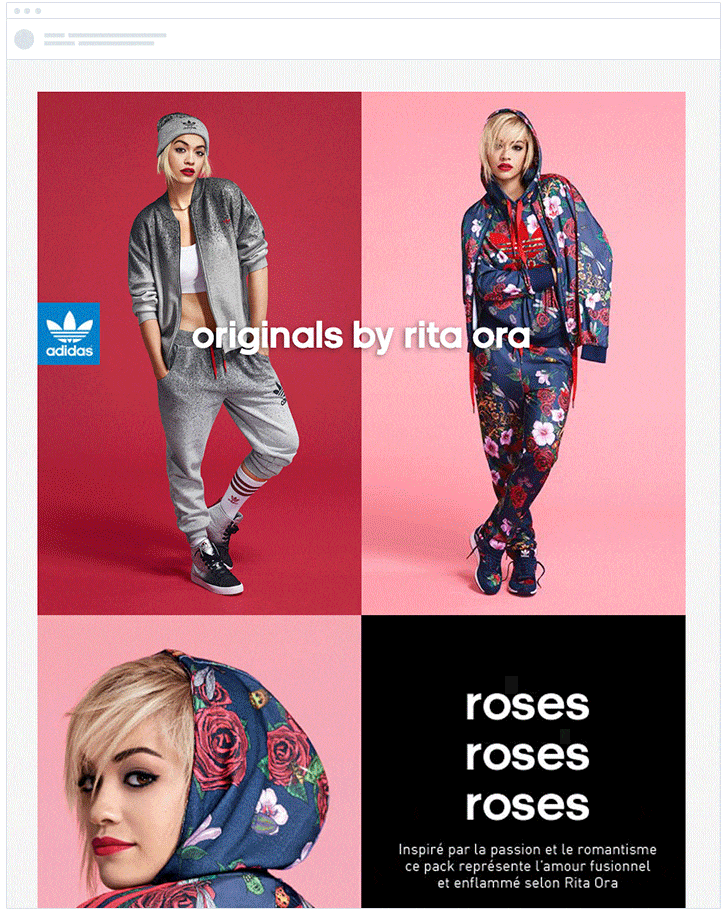
Adidas nurture email personalized by gender.
2. Segment your leads
Avoid sending the same nurture email campaign to everyone on your list. Imagine sending a nurture email about back-to-school supplies to your entire list, including business buyers. It’d be a disaster that may result in your emails being reported as spam.
So, ensure you segment your leads list and write different email nurture campaigns for each segment. This will enable you to send more targeted and personalized nurture emails to each lead.
There are numerous ways to segment your list, including by demographics, geographic, psychographic, and behavioral characteristics. However, at the most basic level, your leads list should be segmented into new, cold, warm, and dead leads.
Let’s say you run a travel company. You could segment your list into those who clicked on the CTA in an email about a destination, those who opened but didn’t click, and those who didn’t engage at all.
Then, you can send different nurture email campaigns to get them to book a destination vacation, click on the link in the email, and open your email, respectively.
3. Map out your buyer’s journey
Your buyer’s journey consists of the different stages your leads and contacts will go through before they convert to customers – broadly, the awareness, consideration and decision stages.
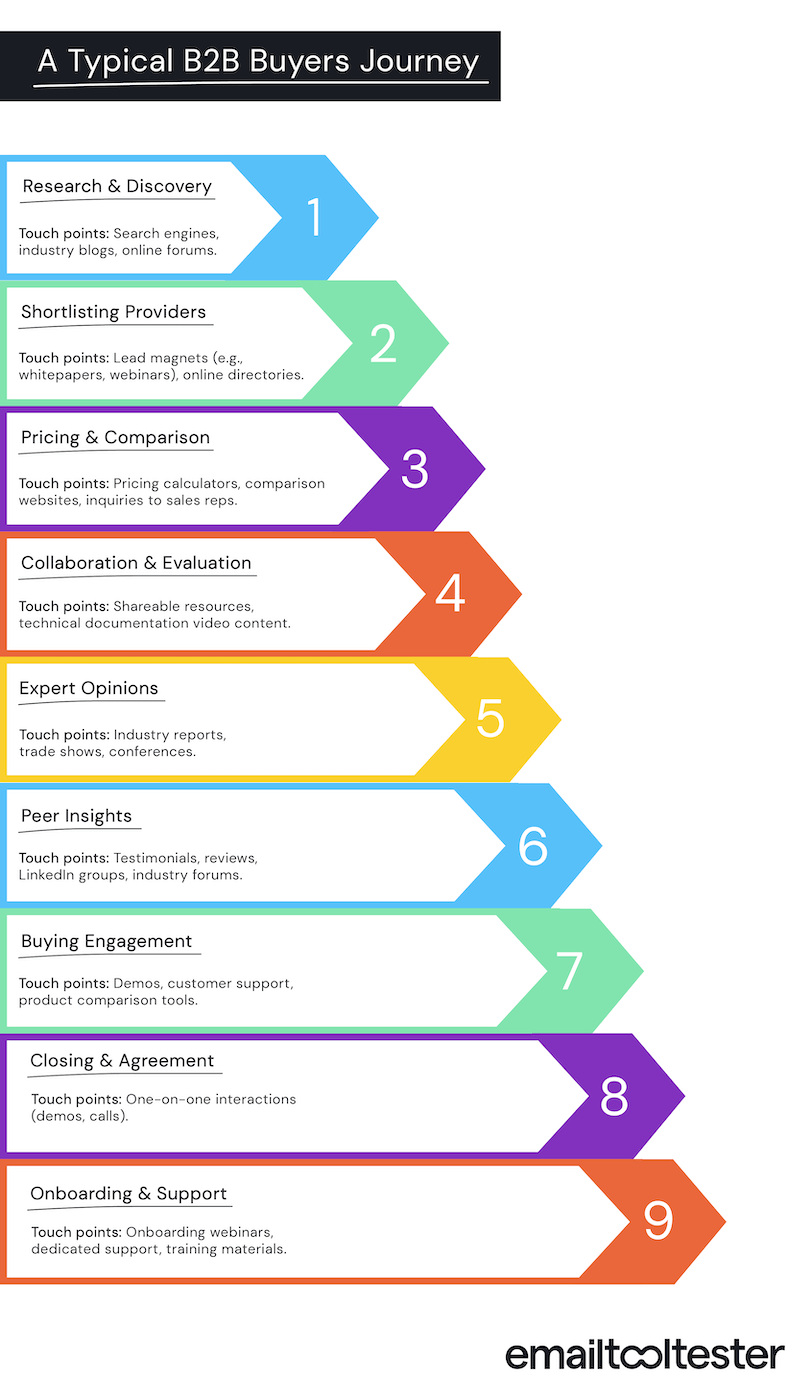
A typical buyers journey in B2B
Mapping out this journey helps you create an effective email nurturing strategy. It enables you to identify the points to trigger an automated email nurture sequence that is relevant to, and personalized for, your leads.
For instance, a fitness website that has mapped its buyer’s journey can trigger a nurture email campaign when leads visit their website and subscribe to their newsletter (Research & Discovery stage).
Then, send another campaign when they attend a free virtual fitness class (Shortlisting Providers stage). And yet another when they express interest in a personalized training program (Buying Engagement stage).
4. Create a series of nurture emails
A single nurture email is not enough to develop a relationship with leads. Ideally, you should have a nurturing sequence comprising several emails that engage leads over time.
So, create a series of nurture emails that are triggered based on your leads’ actions or behaviors. And, make sure that each email is relevant and valuable to your leads, and builds on the progress of the previous email.
Of course, some single nurture emails, such as an abandoned cart email, work well. Still, instead of a single abandoned cart email, you could create an abandoned cart nurture email sequence of up to three emails.
5. Leverage email marketing automation
Email nurture campaigns involve sending several different emails. This can be cumbersome and almost impossible to do manually.
Fortunately, the best email marketing services provide email marketing automation tools that you can use to easily set up your nurture emails to be sent automatically when triggered.
All you have to do is define the specific action your leads have to take for the email you have cued up to be sent automatically. This action could be opening your email, clicking on the CTA, or viewing a landing page.
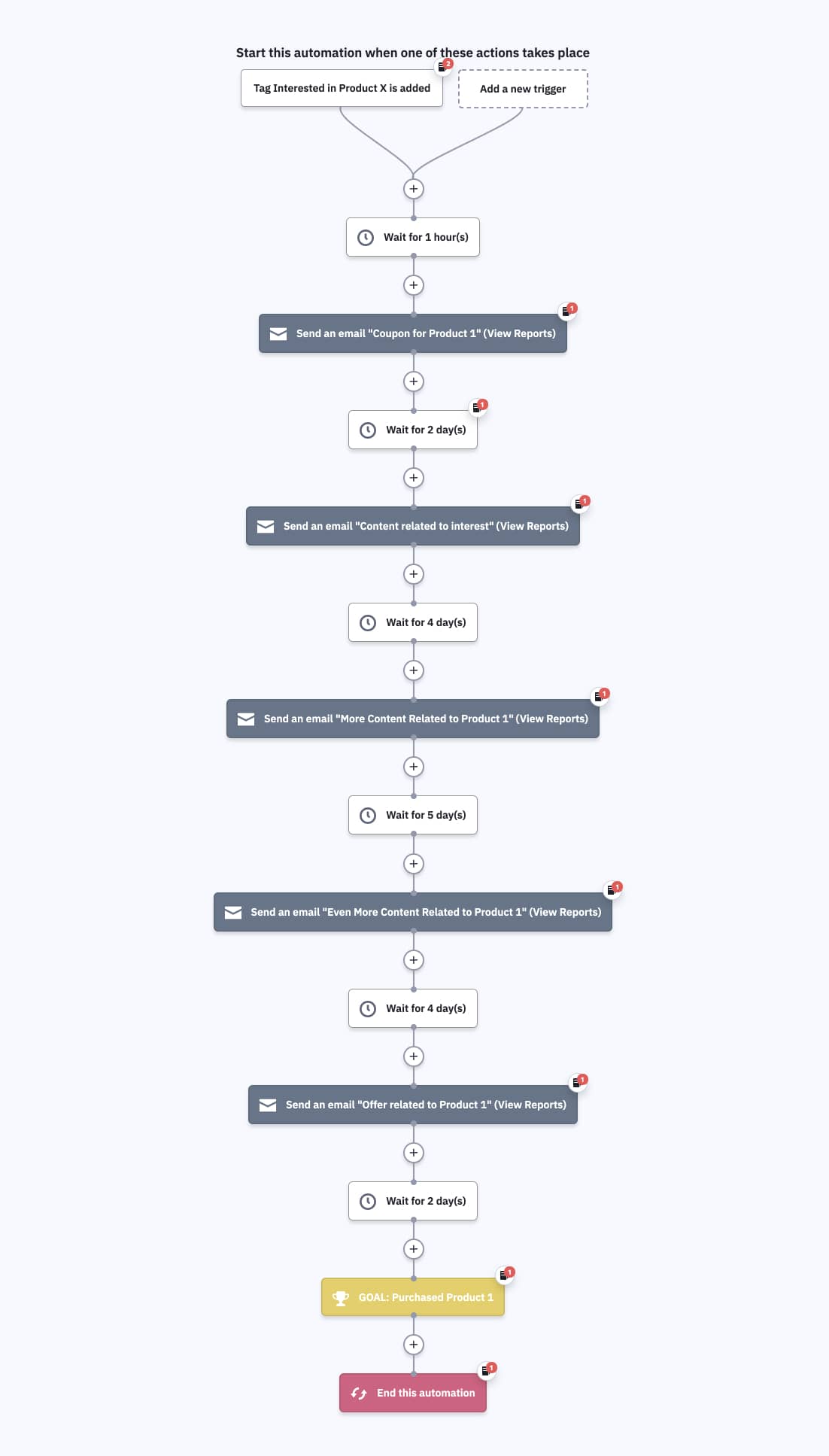
Automated email nurture campaign flow. Source: ActiveCampaign
You can even connect the automation to other marketing channels. For instance, if you have a Facebook lead magnet campaign offering an ebook, you could set up a nurture email campaign to automatically trigger after the delivery of the ebook.
6. Highlight your business USP
Just because you’re building a relationship with contacts doesn’t mean you shouldn’t promote your business. Sure, don’t be salesy or pushy, but you need to highlight your business’s unique selling proposition.
Email nurture campaigns allow you to educate leads about your business and tackle any reticence about your products. You can do this by offering free resources, sharing case studies, and telling stories that build credibility.
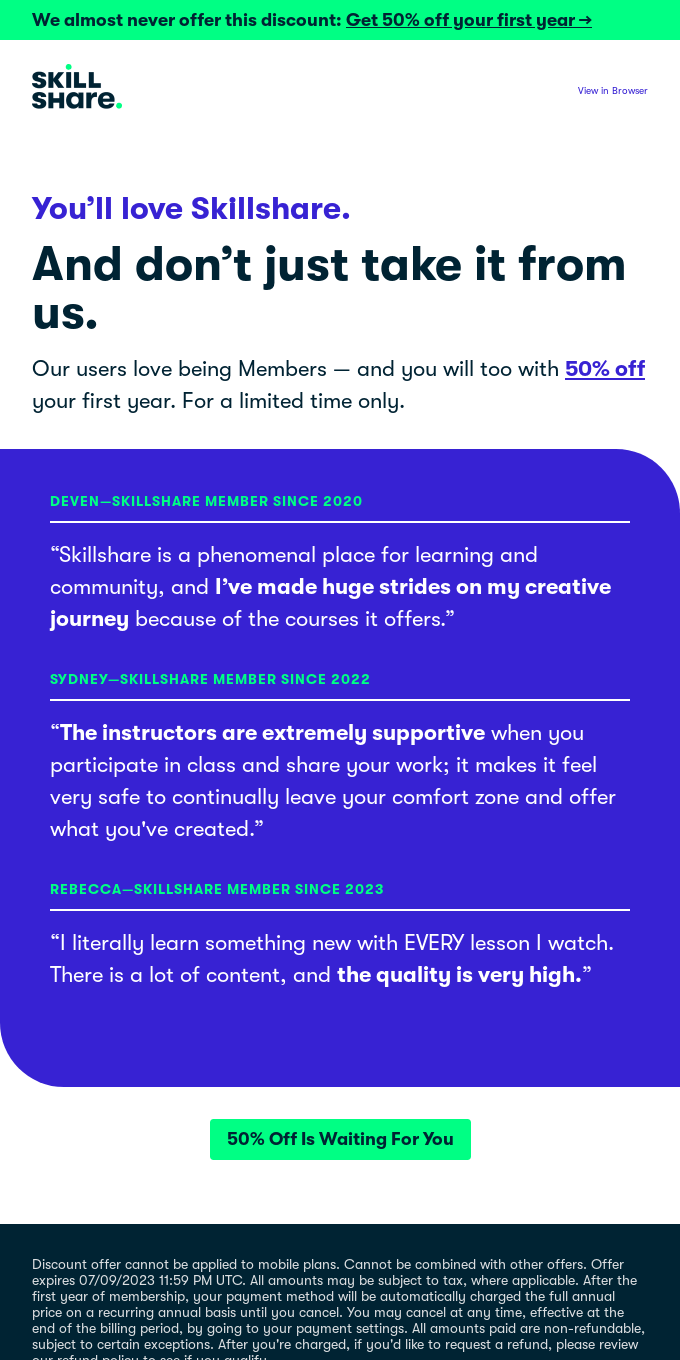
Testimonial nurture email highlighting business USP. Source: Really Good Emails
7. Test, track, and optimize
Conduct A/B tests to determine exactly what works best to engage leads. You can test your nurture email subject lines, content length and CTA, as well as the time you send the emails. Check out the other elements you can A/B test here.
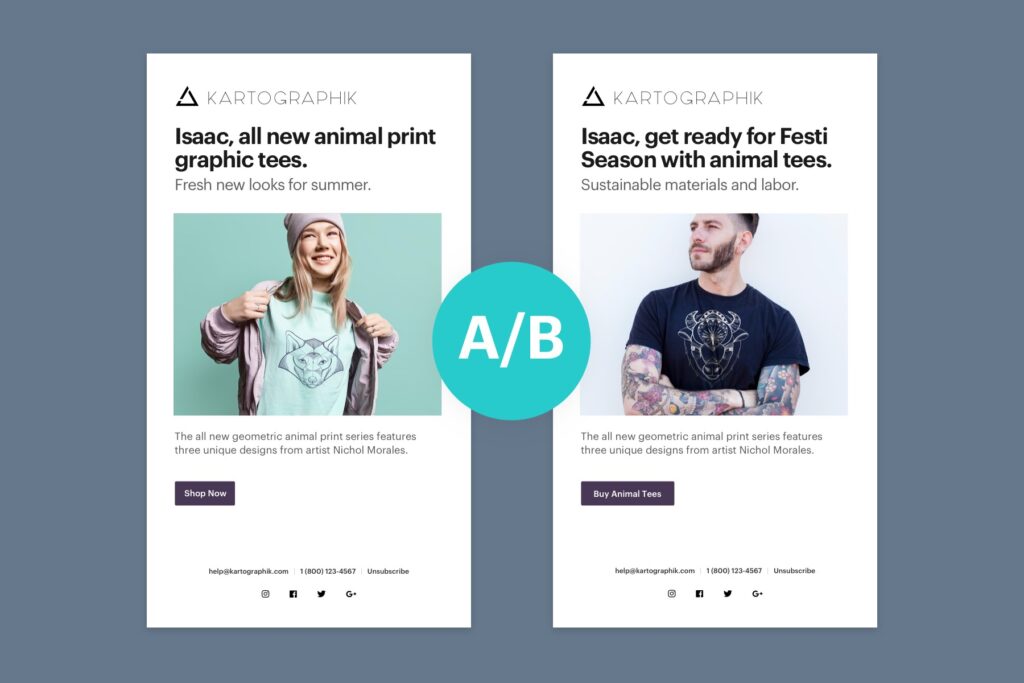
Example of A/B testing. Source: Weebly
You also need to track and analyze the result of your email nurture campaigns. This will enable you to identify emails that need improvements and optimize them. Analyzing successful campaigns also helps with identifying and applying what works to others.
With the analytics tool of ESPs like ActiveCampaign and Brevo, you can track important metrics like open rates, click-through rates, and unsubscribe rates.
8. Add an unsubscribe button
Just like every other type of email marketing campaign, don’t make it difficult for leads to unsubscribe if they want to – add an unsubscribe button at the bottom of your nurture email.
To prevent leads from unsubscribing, avoid bombarding them with too many nurture emails. Offer the option of updating their preferences, and provide a lot of value in your emails that will get them invested in your relationship and business.
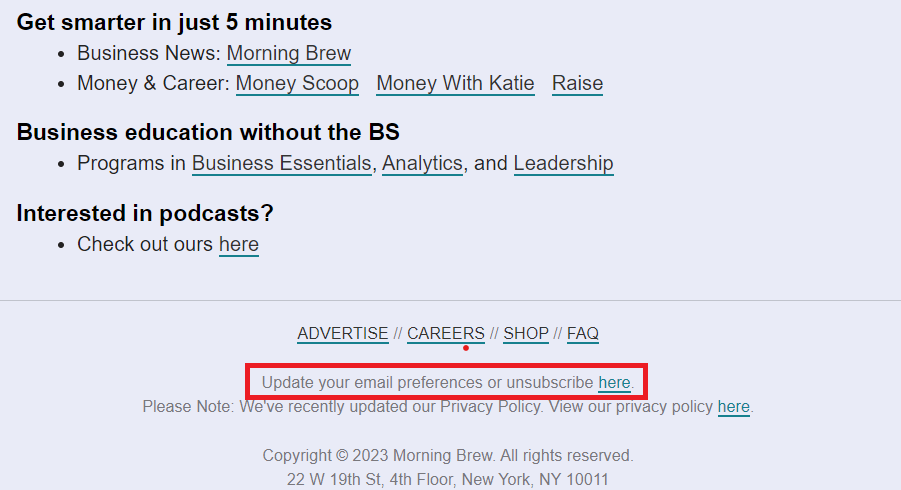
Email with a preference update and unsubscribe button.
How to Write an Email Nurture Campaign
To write an email nurture campaign that builds strong relationships with your leads and will ultimately convert them, you must offer content that they need, when they need it. Here’s how:
1. Define your email nurture campaign goal
Define why you’re creating a nurture email campaign. Is it to build brand awareness and move contacts from the awareness stage to the consideration stage? Or, do you want to nurture them to complete an abandoned order?
Whatever your goal, defining it will enable you to write more focused emails that are more likely to nurture your contacts effectively and achieve success.
2. Write different emails for each segment
Remember, not all your contacts are at the same stage of the buyer’s journey. So, in order to move them down the funnel, you have to write different email nurture campaigns for leads in different stages of that journey.
You do this by segmenting your leads into different groups based on which stage they’re at (more on this later).
For instance, leads who download a lead magnet ebook on building a solid personal finance plan differ from those who sign up for a webinar on tax planning for high-income earners. The former are in the awareness stage, while the latter are in the consideration stage.
3. Craft attention-grabbing subject lines
Your email subject line determines whether or not your contacts will open your email. And, they have to open and read the email in order to be nurtured!
So, ensure you craft an attractive email subject line that will grab your leads’ attention and compel them to open your nurture emails. One way to do this is by personalizing the subject line. Check out this guide on crafting attractive subject lines.

An example of an email subject line personalized with the lead's name.
4. Create valuable email content
Even though they help you convert leads to customers, nurture email campaigns shouldn’t be salesy. Instead, create valuable content that addresses your leads’ pain points and offers solutions to their problems.
Providing value will establish you as an expert that they can trust. Also, use clear and concise language that makes it easy to read and understand your nurture emails.
5. Add visual elements
Although appropriate paragraphing helps make text emails more engaging, emails with only text can seem boring. So, to make your nurture emails more appealing, add visual elements like gifs, images, and infographics.
You could use images from your business activities or personal pictures of you and your staff to connect with leads. For example, signing out your emails with a selfie can be quite appealing, like in the email below.
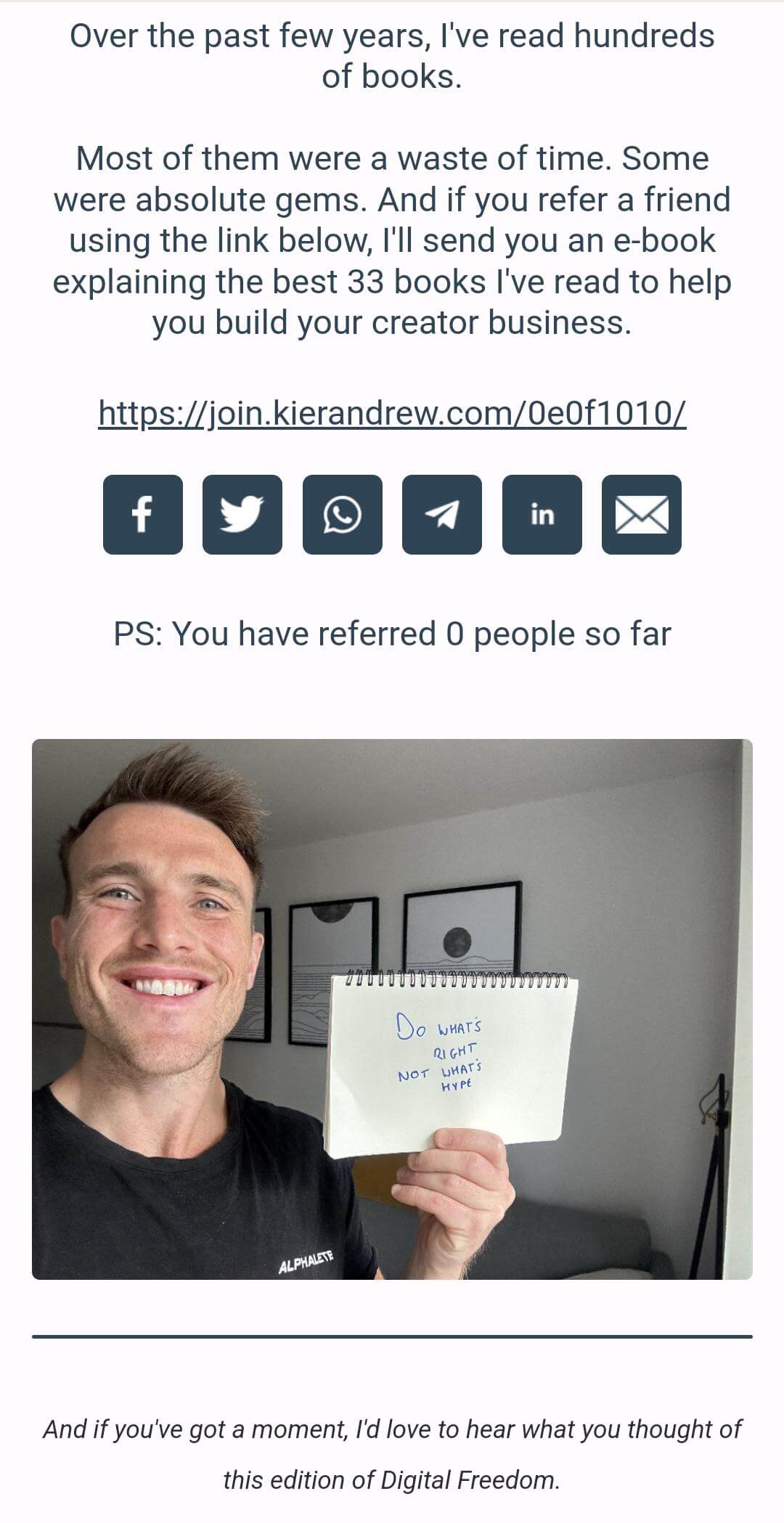
Email closing with a selfie image of the sender.
6. Include an appropriate CTA
Just because your email nurture campaign is for building a relationship, doesn’t mean you shouldn’t include a CTA. But, bear in mind that a call to action (CTA) doesn’t necessarily mean asking leads to buy something.
You can include other types of helpful CTAs, such as downloading a valuable resource, registering for a webinar, scheduling a free consultation, etc.
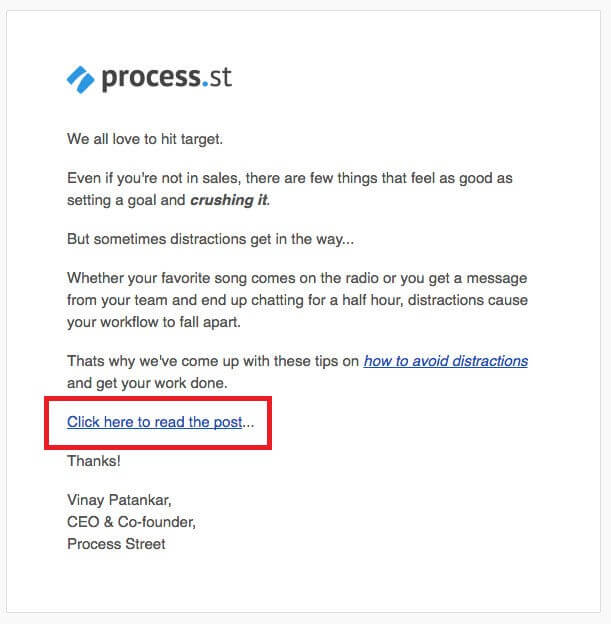
An example of a lead nurture email with a CTA. Source: Sales Wings App
Email Nurture Campaigns Conclusion
Now that you know what an email nurture campaign is and how to write one to convert leads, it’s time to put what you’ve learned into action.
There’s nothing like building a strong relationship with your leads. It enables you to connect with them on a personal level, which helps increase email engagements, convert leads, and retain customers.
Remember that building a long-lasting relationship through lead nurturing entails sending valuable and relevant nurture emails, targeted and personalized for your leads. And, don’t forget to always highlight your unique selling proposition (subtly).
That’s it! Feel free to ask questions or share your experience with email nurturing campaigns in the comments.
We keep our content up to date
21 Sep 2023 - Buyer's Journey infographic added
Our Methodology
This article has been written and researched following our EmailTooltester methodology.
Our Methodology